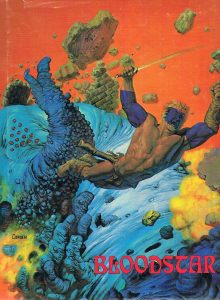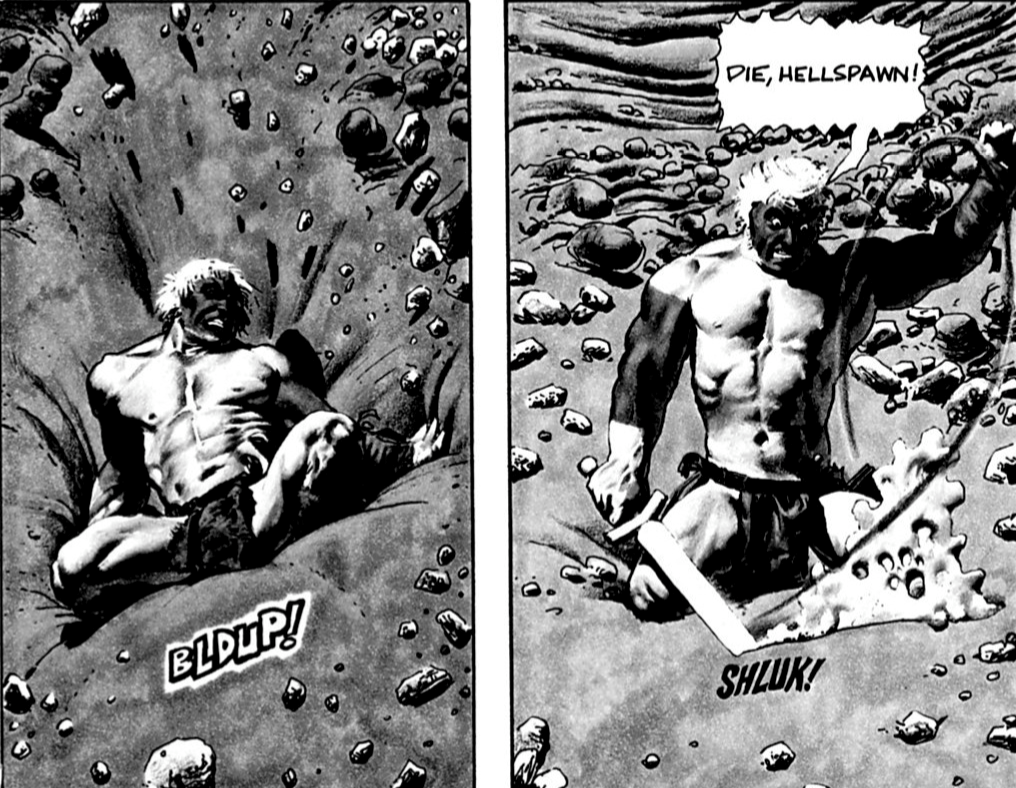The Glory of the Æsir:
Bloodstar
Posted By
Alex Graham
On
In
North American New Right
| Comments Disabled
Richard Corben, Robert Ervin Howard, & John Jakes
Bloodstar [2]
Leawood, Kan.: Morning Star Press, 1976
Bloodstar is a post-apocalyptic sword-and-sorcery graphic novel based on a short story by Robert E. Howard (“The Valley of the Worm,” from the February 1934 issue of Weird Tales) about a warrior who must defeat a giant worm-like creature that threatens to destroy his race. Published in 1976, it pioneered the medium of the graphic novel, and was the first graphic novel to describe itself as such in print.[1] [3] Jewish cartoonist Will Eisner’s A Contract with God and Other Tenement Stories is sometimes referred to as the first self-proclaimed graphic novel, but Bloodstar was published two years earlier.
The creators of Bloodstar sought to combine “the visual power of comic strip art with the richness of a traditional novel,” and the book blends images and dialogue with textual interludes and extensive narration. Each chapter begins with a page of text. The writing is actually very good.
Richard Corben’s black-and-white artwork is excellent. His ink wash renderings are vivid, multi-textured, and highly effective in their use of light and shadow. He is particularly adept at portraying musculature.
The first chapter of Bloodstar is drawn from H. G. Wells’ “The Star,” a short story about a star hurtling toward Earth that causes massive ecological disruption. Earth’s brush with the star wipes out civilization and nearly destroys all life on the planet. New York is buried under mud and volcanic ash, Rome is buried under a glacier, and London and Moscow are submerged underwater. Humans return to the ways of their barbaric ancestors and organize themselves into close-knit tribes.
Unlike Howard’s short story, which is set in the distant past, Bloodstar takes place in the future. But Howard envisioned his dragon-slaying heroes as a recurring archetype that appeared in cycles, so it fits that the story would play out in the future as well.
The main difference, apart from the chronological discrepancy, is that the story is narrated by Grom instead of James Allison. (“The Valley of the Worm” is the last of eight stories by Howard in which Allison, a man living in 1930s Texas, recounts his past lives as ancient heroes while on his deathbed.) Also, Niord is called “Bloodstar,” and the “naked tousle-headed girl” is given the name “Helva” and becomes a more prominent character. The characters of Loknar and Byrdag do not exist in the original story, nor do the “teeth of Ymir” and so on. Overall, though, Bloodstar is faithful to the original.
The eponymous protagonist, Bloodstar, belongs to a race of fair-haired warriors called the Æsir [4], whose name hearkens back to Norse paganism (the Æsir were the more warlike pantheon, as distinguished from the Vanir, though the term can also refer to the unified pantheon of Norse deities that emerged after the Æsir-Vanir War). He describes himself thus in Howard’s tale:
I have never been any but a man of that restless race men once called Nordheimr and later Aryans, and today name by many names and designations. Their history is my history, from the first mewling wail of a hairless white ape cub in the wastes of the Arctic, to the death-cry of the last degenerate product of ultimate civilization, in some dim and unguessed future age.
The story of Bloodstar begins with a bloody battle between the Æsir and Grom’s people in which the Æsir are victorious. (In Howard’s story, their victory is attributed to their racial superiority; the Picts, a simian, troll-like race, are fierce warriors, but lack a well-developed “fighting-brain.”) Bloodstar decides to spare Grom and takes him on as his right-hand man. That night, Bloodstar sleeps with Helva, the daughter of the former chieftain. Because tradition dictates that Helva must be chaste until she weds the new chieftain, Bloodstar is dealt the punishment of being subjected to the “teeth of Ymir,” an obstacle course from which few men emerge alive. He survives this trial, but he is exiled from the village. Bloodstar retreats to the wilderness, joined by Grom and Helva. During this time, Bloodstar single-handedly slays a saber-toothed tiger. Helva bears a son, also named Bloodstar.
Things take a turn for the worse when Helva is abducted. While searching for her, Bloodstar and Grom stumble upon an Æsir encampment that lies in ruins. (Meanwhile, the younger Bloodstar wanders off and is retrieved by Byrdag, Helva’s father.) Bloodstar learns that the inhabitants were slaughtered by a gargantuan Lovecraftian entity known as the King of the Northern Abyss, or the Worm in the original. Howard describes it as “a night-born demoniac intelligence such as men in dreams vaguely sense throbbing titanically in the black gulfs outside our material universe.” It is associated with the Old Ones: “The white monster in the pits was their god, summoned up from the nighted abysses of mid-earth uncounted fathoms below the black mould by sorcery unknown to the sons of men.”
After fighting a giant serpent in order to coat his arrows in its venom, Bloodstar sets out to fight the Worm. He paints his face and limbs, “as is the Æsir custom when a warrior knows he is going to certain doom,” and prays to Ymir. (In Norse mythology, Ymir is the ancestor of the jötnar and is the first being to be created.)
He first confronts Loknar, who has transformed into a ghastly creature covered in hair. Loknar summons the worm from an abyss by playing a tune on his pipe. Bloodstar kills Loknar with his axe and proceeds to fight the Worm – a gigantic, shapeless, fleshy creature with large tentacles. He shoots it with arrows and then rips its skin with his sword.
The Worm flings him into the sky, and Bloodstar is fatally injured. The Worm itself then dies, melting as it slides back into the abyss. The dying Bloodstar requests that his son pass on the tale of his victory over the Worm. From the Epilogue:
Thus ends the tale of Bloodstar the Elder.
But the glory of the Æsir continued on in his son, and in his son’s children, who sailed strange ships of wood and stone back to the icebound headlands of their tribe’s origin.
And it came to pass that those sons of Bloodstar founded the dynasty which came to be known as the Northern Ring, or Kingdom of Frozen Light.
Its warriors traveled the world’s white-foaming seas in quest of new lands and lost tribes.
Its explorers charted the perilous passages through the Smoking Realms. . . .
Many deeds of heroism those sons of Bloodstar performed and recorded, above the land and in the underworlds beneath it. . . .
For always they hearkened back to the memory of the King of the Northern Abyss, and the man of Æsir blood who gave his life to slay that ancient evil.
It goes on to say that Bloodstar’s descendants founded a city called Helvatica, where they flourished, and that they preserved the memory of the sacrifices of Bloodstar, Grom, Helva, and Byrdag.
Bloodstar’s fight against the Worm resembles the Chaoskampf motif in Indo-European mythology, in which a hero or deity is tasked with battling chaos in the form of a monster (usually a serpent or dragon). Examples of this include Hercules and the Hydra, Thor and Jörmungandr, Ra and Apep, and so on. The battle is associated with the act of creation and the establishment of order. Here, Bloodstar must defeat the Worm in order to secure a future for his descendants and bring about the creation of a new civilization. He uses a bow and arrow, which is often a solar or phallic symbol in mythology and represents his alignment with the forces of order and creation.
Each foe Bloodstar encounters is more emblematic of chaos (and more distant from humans) than the one before it: first Grom, then a saber-toothed tiger, then a serpent, and finally the Worm. The Worm, “a formless elemental spirit drawn up from below,” represents the ultimate form of chaos.
Bloodstar highlights the fact that civilization is extremely fragile and can collapse at any time, and that the qualities most needed in the event of societal collapse are heroism and strength. It recalls a famous quote from one of Howard’s Conan the Barbarian stories: “Someday, when all your civilization and science are likewise swept away, your kind will pray for a man with a sword.”
Bloodstar has been out of print for decades, and most copies on the market are very expensive, but it is available on Scribd [2]. It is a must-read for fans of Howard and Corben, those interested in the history of comics, or anyone who simply likes a good adventure tale.
Note
[1] [6] George Metzger’s Beyond Time and Again and Jim Steranko’s Chandler: Red Tide also billed themselves as “graphic novels” and were published in the same year, but the former was a serialized comic, while the latter is considered a work of illustrated fiction rather than a graphic novel.

